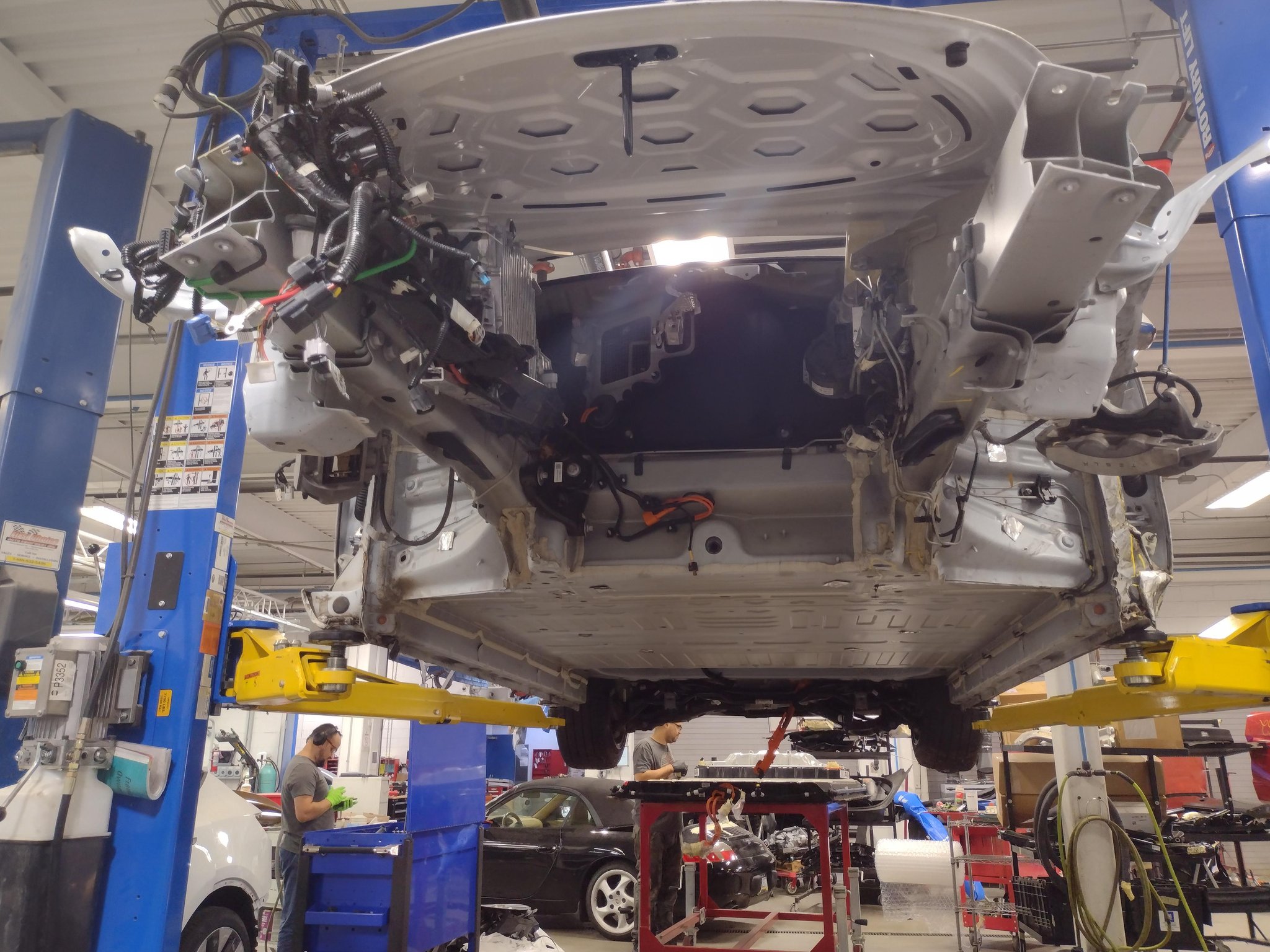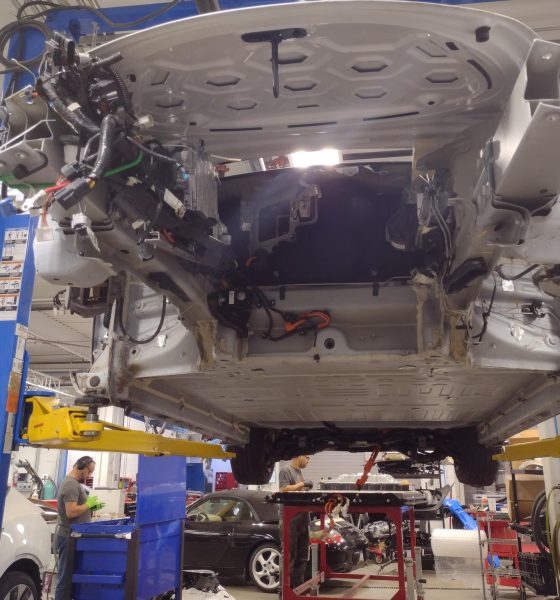

News
Tesla Cybertruck lead engineer shares insights on deep integration and vehicle development
Tesla Cybertruck Lead Engineer Wes Morrill recently shared some insights on the electric vehicle maker’s deep integration and unique approach to car design in a recent post on social media platform X. As could be seen in the engineer’s post, it is Tesla’s intense attention to detail that ultimately makes the company’s vehicles as disruptive as they are today.
Anyone informed who looks at the Tesla Cybertruck would know that the vehicle is a symphony of automotive engineering. Tesla, however, took some time before it reached this point. As per Morrill in his post, Tesla in its early days utilized different teams with collaborative goals in vehicle design. Adopting this system allowed the company to make great cars, but the designs of the vehicles themselves were not optimal.
“A well known example – early days of Tesla there was a battery team and separately a vehicle structures team. Structures team designed their vehicle body to meet given requirements of strength, crashworthiness, torsional stiffness, etc. Likewise, the battery team designed their part to be self contained, it could survive durability, accidentally being dropped, being hit in a crash, etc.
Good analysis – this is what happens when teams work together to make the best product. https://t.co/XAXf70k3jc— Wes (@wmorrill3) September 14, 2024
“As a result, we ended up with was a super dense battery in a strong box like structure, which was then Installed into the vehicle which had a nice space for it to mate into. There were no issues with integration, everything fit together perfectly and met all product goals. It achieved one of the highest crash safety ratings measured at the time.
“But we had a box full of battery cells that was installed into another empty box shaped receptacle on the body. A box in a box. When you simplify it down that far it sounds obviously wrong. The two organizations had achieved their goals, worked together without friction, and the product met its overall goals. Yet the product ended up with a clear lack of optimization as a result of the organizational boundaries of the two teams working in isolation. Nothing was wrong, but it wasn’t optimal,” Morrill wrote.
The Cybertruck Lead Engineer noted that Tesla learned from these experiences, and the company adapted. This is how innovations such as the structural battery pack—which is now being simulated by electric car makers in China—came about. Morrill stated, however, that such changes may require large organizational changes, and there has to be a drive to make the best product regardless of ego.
Have you heard of Conway's Law? It's an interesting observation about the root cause of why large organizations usually make products worse.
In 1967 Melvin Conway wrote "Organizations which design systems are constrained to produce designs which are copies of the communication… pic.twitter.com/SetWd6OfTe— Wes (@wmorrill3) September 14, 2024
“Before the next product was designed, the battery team gave responsibility of the battery structures also to the vehicle structures team. On this iteration, we ended up with the structural battery, which is an integral part of the body and crash structure. Without it, the vehicle body will not work. It’s the literal floor for the vehicle. But the redundancy is gone and the design is more efficient as a result. This vehicle also achieved one of the highest crash safety ratings measured at the time.
“This is a super obvious example (in retrospect) and solved with a fairly large organizational change but you can also see this happen in small technical decisions and doesn’t require structural change to fix. Someone just needs to question if there is a better solution in a team open to criticism. This mindset to work together to make the best product regardless of ego is where you end up with the most innovative products.
“Some smaller examples have been seen when inspecting Cybertruck design. The chassis air suspension which is used to pressurize the battery pack to prevent water ingress. The subwoofer which utilizes the air volume of the body side instead of making the enclosure larger. Centralized zonal vehicle controllers instead of many small distributed controllers. Doors which use the exterior surface as a crash intrusion beam. The pedestrian warning system used as a horn. The list goes on. The excitement and motivation by everyone involved to work across boundaries and actively break down Conway’s Law is one of the many reasons I love working at Tesla,” Morrill wrote.
Don’t hesitate to contact us with news tips. Just send a message to simon@teslarati.com to give us a heads up.

Elon Musk
Tesla’s Elon Musk: 10 billion miles needed for safe Unsupervised FSD
As per the CEO, roughly 10 billion miles of training data are required due to reality’s “super long tail of complexity.”

Tesla CEO Elon Musk has provided an updated estimate for the training data needed to achieve truly safe unsupervised Full Self-Driving (FSD).
As per the CEO, roughly 10 billion miles of training data are required due to reality’s “super long tail of complexity.”
10 billion miles of training data
Musk comment came as a reply to Apple and Rivian alum Paul Beisel, who posted an analysis on X about the gap between tech demonstrations and real-world products. In his post, Beisel highlighted Tesla’s data-driven lead in autonomy, and he also argued that it would not be easy for rivals to become a legitimate competitor to FSD quickly.
“The notion that someone can ‘catch up’ to this problem primarily through simulation and limited on-road exposure strikes me as deeply naive. This is not a demo problem. It is a scale, data, and iteration problem— and Tesla is already far, far down that road while others are just getting started,” Beisel wrote.
Musk responded to Beisel’s post, stating that “Roughly 10 billion miles of training data is needed to achieve safe unsupervised self-driving. Reality has a super long tail of complexity.” This is quite interesting considering that in his Master Plan Part Deux, Elon Musk estimated that worldwide regulatory approval for autonomous driving would require around 6 billion miles.
FSD’s total training miles
As 2025 came to a close, Tesla community members observed that FSD was already nearing 7 billion miles driven, with over 2.5 billion miles being from inner city roads. The 7-billion-mile mark was passed just a few days later. This suggests that Tesla is likely the company today with the most training data for its autonomous driving program.
The difficulties of achieving autonomy were referenced by Elon Musk recently, when he commented on Nvidia’s Alpamayo program. As per Musk, “they will find that it’s easy to get to 99% and then super hard to solve the long tail of the distribution.” These sentiments were echoed by Tesla VP for AI software Ashok Elluswamy, who also noted on X that “the long tail is sooo long, that most people can’t grasp it.”
News
Tesla earns top honors at MotorTrend’s SDV Innovator Awards
MotorTrend’s SDV Awards were presented during CES 2026 in Las Vegas.

Tesla emerged as one of the most recognized automakers at MotorTrend’s 2026 Software-Defined Vehicle (SDV) Innovator Awards.
As could be seen in a press release from the publication, two key Tesla employees were honored for their work on AI, autonomy, and vehicle software. MotorTrend’s SDV Awards were presented during CES 2026 in Las Vegas.
Tesla leaders and engineers recognized
The fourth annual SDV Innovator Awards celebrate pioneers and experts who are pushing the automotive industry deeper into software-driven development. Among the most notable honorees for this year was Ashok Elluswamy, Tesla’s Vice President of AI Software, who received a Pioneer Award for his role in advancing artificial intelligence and autonomy across the company’s vehicle lineup.
Tesla also secured recognition in the Expert category, with Lawson Fulton, a staff Autopilot machine learning engineer, honored for his contributions to Tesla’s driver-assistance and autonomous systems.
Tesla’s software-first strategy
While automakers like General Motors, Ford, and Rivian also received recognition, Tesla’s multiple awards stood out given the company’s outsized role in popularizing software-defined vehicles over the past decade. From frequent OTA updates to its data-driven approach to autonomy, Tesla has consistently treated vehicles as evolving software platforms rather than static products.
This has made Tesla’s vehicles very unique in their respective sectors, as they are arguably the only cars that objectively get better over time. This is especially true for vehicles that are loaded with the company’s Full Self-Driving system, which are getting progressively more intelligent and autonomous over time. The majority of Tesla’s updates to its vehicles are free as well, which is very much appreciated by customers worldwide.
Elon Musk
Judge clears path for Elon Musk’s OpenAI lawsuit to go before a jury
The decision maintains Musk’s claims that OpenAI’s shift toward a for-profit structure violated early assurances made to him as a co-founder.

A U.S. judge has ruled that Elon Musk’s lawsuit accusing OpenAI of abandoning its founding nonprofit mission can proceed to a jury trial.
The decision maintains Musk’s claims that OpenAI’s shift toward a for-profit structure violated early assurances made to him as a co-founder. These claims are directly opposed by OpenAI.
Judge says disputed facts warrant a trial
At a hearing in Oakland, U.S. District Judge Yvonne Gonzalez Rogers stated that there was “plenty of evidence” suggesting that OpenAI leaders had promised that the organization’s original nonprofit structure would be maintained. She ruled that those disputed facts should be evaluated by a jury at a trial in March rather than decided by the court at this stage, as noted in a Reuters report.
Musk helped co-found OpenAI in 2015 but left the organization in 2018. In his lawsuit, he argued that he contributed roughly $38 million, or about 60% of OpenAI’s early funding, based on assurances that the company would remain a nonprofit dedicated to the public benefit. He is seeking unspecified monetary damages tied to what he describes as “ill-gotten gains.”
OpenAI, however, has repeatedly rejected Musk’s allegations. The company has stated that Musk’s claims were baseless and part of a pattern of harassment.
Rivalries and Microsoft ties
The case unfolds against the backdrop of intensifying competition in generative artificial intelligence. Musk now runs xAI, whose Grok chatbot competes directly with OpenAI’s flagship ChatGPT. OpenAI has argued that Musk is a frustrated commercial rival who is simply attempting to slow down a market leader.
The lawsuit also names Microsoft as a defendant, citing its multibillion-dollar partnerships with OpenAI. Microsoft has urged the court to dismiss the claims against it, arguing there is no evidence it aided or abetted any alleged misconduct. Lawyers for OpenAI have also pushed for the case to be thrown out, claiming that Musk failed to show sufficient factual basis for claims such as fraud and breach of contract.
Judge Gonzalez Rogers, however, declined to end the case at this stage, noting that a jury would also need to consider whether Musk filed the lawsuit within the applicable statute of limitations. Still, the dispute between Elon Musk and OpenAI is now headed for a high-profile jury trial in the coming months.








